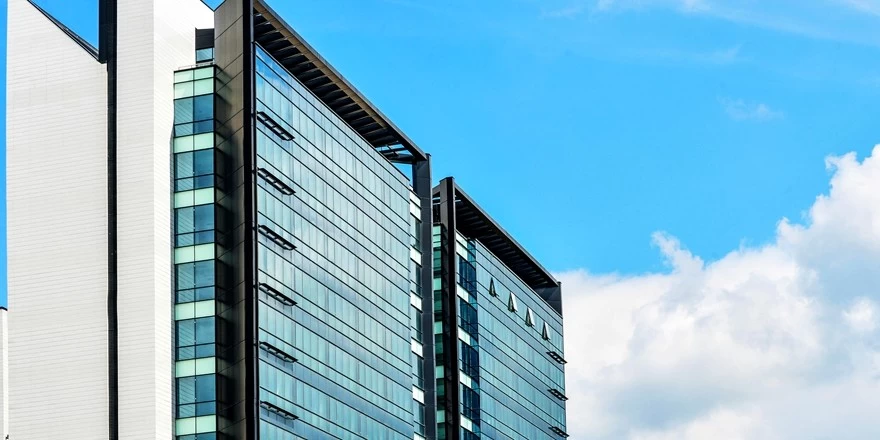Safe Selection Of Curtain Wall Building Glass
The safe selection of glass is a key issue in curtain wall architectural and structural design. Safety glass is only an artificial division, and the types and performance of safety glass vary. It cannot be simply stated that curtain walls should be used safety glass, and different types of glass should be selected according to the different requirements of each part of the curtain wall.
A key issue in the design and construction of glass curtain walls is the rational selection of glass
Construction building glass curtain wall factory
Glass is a very brittle material, so there cannot be safe glass. The use of glass in buildings inevitably carries certain risks. Safety glass generally refers to glass (tempered glass) with a relatively low risk of personal injury. Due to the lack of absolute safety glass, the safety of glass can only be relative. Therefore, glass should be selected reasonably according to the functional requirements of different parts of the curtain wall, striving for maximum safety in use and minimizing the risk of personal and property damage.

In fact, in recent years, almost all the glass that has caused injuries and damage to people and objects is single-piece tempered glass that belongs to the category of "safety glass"; However, the strengthened glass curtain wall included in nonsafety glass has not reported any safety accidents. Even many glass windows using float glass have not heard of such sensational accident reports as tempered glass.
(1) Tempered glass has caused frequent curtain wall accidents in recent years
In the 21st century, due to various reasons, glass curtain walls have become the dominant of tempered glass. "All curtain wall glass must be tempered" seems to be the default, and strengthened glass widely used in the 1980s and 1990s has withdrawn from the stage of history.
However, in recent years, tempered glass accidents have occurred frequently, and the fact that many personal injuries and property losses have occurred has ruthlessly denied the view that "tempered glass is safe". The fact that strengthened glass, known as non-safety glass, does not cause accidents, while tempered glass, known as safety glass, frequently encounters problems, cannot but arouse people's reflection.
A piece of tempered glass on the 5th floor of a commercial building suddenly blew up and injured the left hand of a music teacher, causing disability and making it impossible to play again.

More than 50 pieces of tempered glass in a convention and exhibition center blew up one after another. At that time, the ASEAN Expo was about to open, and leaders of various countries gathered. In order to meet the requirements of ensuring absolute safety, special explosion-proof membranes have to be affixed at a high cost. Its cost far exceeds the laminated glass that was originally proposed.
There are also some news reports that the tempered bathroom glass used in the home exploded. At that time, the owner was injured by the slag in the shower. On the contrary, the strengthened glass used since the 1990s, although not safety glass, has not yet heard of any accidents.
Comparing the two, isn't it reflective?
(2)Self-explosion of tempered glass is unavoidable
Self-explosion is a characteristic of tempered glass and cannot be avoided. This is the consensus of the industry. In order to reduce the self-explosion rate, it can only be achieved by selecting a high-quality float glass sheet and conducting secondary heat treatment. Even so, the 1% self-explosion rate is already the limit and cannot be further reduced. A self-explosion rate of one thousandth to two percent is already a high-quality product, which means that it is completely normal for a project to blow a few pieces or more pieces, and everyone will not find it strange.

But even if a piece of glass bursts, it can potentially harm people and cause serious consequences. Moreover, people outside the industry are unaware that this is a normal situation, and there will be riots all over the city, and the media will hype everywhere, turning trivial matters into big ones, making it difficult for curtain wall glass manufacturers to parry.
The self-exploding glass must be replaced, but the cost of replacement far exceeds that of the glass itself. It is even more difficult and dangerous to replace it in high-rise curtain walls and irregular curtain walls.
Moreover, once a self-explosion occurs, it means that similar events may occur in the future, but when and where are unknown, causing people to lose their sense of security.
(3) Careful use of tempered glass in public buildings
In recent years, facts have shown that tempered glass, as a "safety glass" used in densely populated public buildings, poses significant safety hazards, causing both owners and visitors to feel unsafe. Because we don't know when, which piece of glass will suddenly explode, hurting people and ruining faces.
So in densely populated public buildings, when it is necessary to use single-tempered glass, it must be treated with caution and necessary safety measures must be taken:
1. Tempered glass needs secondary heat treatment, that is, heat soak tempered treatment, to detonate glass containing self-explosive impurities in advance.
2. Install isolation strips under the curtain wall and do not arrange facilities to attract pedestrians and spectators to stay. There are no booths, dining, or sales positions set up indoors against the wall. Outdoor parking spaces should be located away from the wall base, with greenery or water pools arranged at the wall base.

3. Install a canopy at the entrance and exit.
4. Install metal safety nets above the pedestrian flow.
5. Apply the explosion-proof film to the glass.
So what other methods are suitable for the safe use of curtain wall glass? Looking forward to our next article revealing the answers.





















